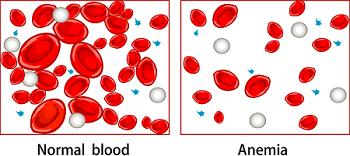Many adults experience symptoms of anemia including fatigue, daytime sleepiness, and lack of energy. Anemia is a condition of low blood hemoglobin. Normal levels of hemoglobin are between 12.5 and 17.0.
Anemia can be a sign of more serious underlying problems. The possible causes of anemia are broad and include blood loss, bleeding, iron deficiency, vitamin B12 and folate deficiencies, renal disease, hereditary anemias like thalassemia, hemolytic anemia, and cancer or blood disorders like leukemia. Another blood disorder, known as MDS or myelodysplastic syndrome, accounts for some anemias as well but thankfully it’s rare.
Anemia should first be checked out by a physician and many patients are referred to hematologists to get a full workup for their anemia. Often, simple causes are discovered like iron deficiency or renal disease. Other times, more extensive workup will need to be done to discover the cause of anemia including scans or other procedures.
Many times, the aging process causes a reduced kidney function. Scientists estimate that humans lose about 1 cc per minute of glomerlular filtration rate (GFR) per year of life. The GFR is the rate at which the kidneys can filter blood to produce urine.
In addition to producing urine, the kidneys also produce a hormone known as EPO or erythropoeitin. This hormone then goes to the bone marrow and stimulates the production of red cells.
With reduced kidney function can come reduced levels of EPO. Hematologists can replace reduced EPO levels with medication called ESAs or erythropoiesis stimulating agents. Erythropoiesis is the process by which the body produces red cells.
These agents, including procrit® and aranesp® and also the newly-approved retacrit®, can help treat anemia due to reduced renal function.
Patients may have more than one cause for anemia so before starting on these medications, they should have a full workup to rule out other causes for anemia.
Many patients find that they have improved energy levels while taking medication like procrit®. Symptoms like fatigue and lack of energy may respond within a week or so to treatment with ESAs.
Medicare guidelines indicate that patients may only start treatment with ESAs in the setting of renal disease for a hemoglobin less than 10.0 and may only continue treatment when their hemoglobin is less than 12.0.
Side effects of ESAs include thickening of the blood and even strokes if the treatment is targeted to hemoglobins above 12.5. Ideally treatments with ESAs would target a hemoglobin between 11 and 12. Blood pressure can also rise with ESA treatment and this should be tracked by your treating doctor.
Hemoglobin is the protein in the red cell that gives it the red color. It is a pigmented molecule that carries oxygen. Doctors can directly measure hemoglobin in the blood by using a laser and a detector to determine the red color of the blood in the lab.
You may also hear about hematocrit and that could be low in the setting of anemia as well. Hematocrit is the percent of blood that is red cells (as opposed to water, called plasma). Usually hematocrit and hemoglobin are related to each other by a factor of 3:1.
Your doctors at Regatta Health are able to instantly check the hemoglobin when you visit the office using FDA-approved technology. If your hemoglobin is low, they may suggest a workup to determine the reasons why, and they may suggest treatment with medication like procrit. Treatment with procrit or other ESAs is usually covered by insurance if treatment guidelines are followed.
